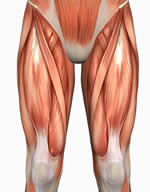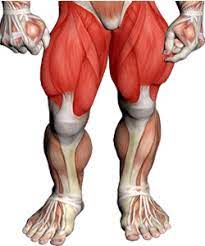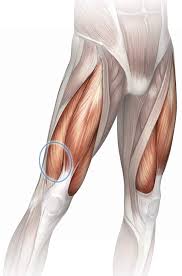

We usually think of neck posture as a concern limited to the upper body—maybe a stiff neck, sore shoulders, or a slouched back.
But here is the twist: that seemingly small forward tilt of your head can sneak all the way down and tighten your quadriceps—the large muscles in the front of your thighs.
It is like a ripple in a pond; one misaligned joint affects the entire kinetic chain. In this article, BestForwardHeadPostureFix shall unpack how and why forward neck syndrome can lead to tight quadriceps, exploring the biomechanical and neuromuscular links from head to hip to thigh.
No fluff, just a full-body logic breakdown.
Article Index
- Understanding Forward Head Posture
- The Body’s Chain Reaction
- The Role of the Pelvis
- Quadriceps Tightness Explained
- Compensatory Mechanisms and Muscle Imbalances
- Neuromuscular Reprogramming
- Fascial Chains and Muscle Tension
- FAQs on Forward Head Posture & Your Quads
- Postural Feedback Loops and Quadriceps Dominance
- Conclusion
Understanding Forward Head Posture
Forward head posture (FHP), also known as forward neck syndrome, is a common postural distortion where the head juts out in front of the body’s vertical midline. In optimal alignment, your ears should rest directly above your shoulders.
However, thanks to the tech-heavy lifestyles of today—constant smartphone use, prolonged laptop sessions, and TV binge-watching marathons—this alignment often gets disrupted. The head drifts forward, pulling the cervical spine into a stressed, misaligned position.
To compensate and keep the body from toppling, the neck extensors, upper back muscles, and thoracic stabilizers are forced to work overtime. This chronic overactivation doesn’t stay confined to the upper body—it causes a ripple effect.
As the spine adapts, the thoracic curve often increases, the pelvis tilts, and muscular chains down to the legs react by tightening. This compensation can result in persistent tension in the hamstrings, hip flexors, and even the quadriceps, changing how we stand, move, and bear weight.
The muscle imbalance in thighs alters your normal walking gait thereby making it rather tough for you to walk normally.
The Body’s Chain Reaction
The human body functions as a finely tuned kinetic chain, where every segment is interconnected. When one part shifts out of alignment, the rest must adapt like dominoes to maintain balance.
In the case of forward head posture (FHP), the skull’s forward displacement throws off the spine’s natural equilibrium.
The thoracic spine compensates by developing hyperkyphosis—a pronounced rounding of the upper back. To keep the torso from collapsing forward, the lumbar spine often deepens into hyperlordosis, which then tips the pelvis anteriorly.
Here is where it gets biomechanically interesting: this forward pelvic tilt doesn’t just affect the spine—it directly impacts the hip flexors. Chief among them is the rectus femoris, a dual-role muscle involved in both hip flexion and knee extension, and a key part of the quadriceps group.
As the pelvis tilts forward, this muscle remains in a shortened state.
And when a muscle is kept shortened for extended periods, it adapts to that length—becoming chronically tight.
This tightness isn’t just uncomfortable—it changes gait, limits hip extension, and increases strain on the knees. Over time, what started as a neck misalignment morphs into a full-body mechanical issue that even affects how we walk, sit, and distribute force through the legs.
The Role of the Pelvis
The pelvis serves as the central anchor of human posture, acting like a keystone in the body’s alignment architecture. When forward head posture (FHP) causes the upper spine to round and the lumbar spine to overarch, the pelvis often tips forward—a condition known as anterior pelvic tilt.
This seemingly small tilt has big consequences. It pulls on the muscles that originate from or attach to the pelvis, particularly the hip flexors and upper quadriceps.
The rectus femoris, one of the four quadriceps muscles, is unique because it crosses both the hip and knee joints. When the pelvis shifts forward, this muscle is placed in a shortened, or “locked-short,” position.
Over time, this static shortening reduces its elasticity, making it harder to extend the leg fully or flex the hip properly. The result? Chronic tightness in the front thighs, reduced stride efficiency, and even discomfort during activities like walking, squatting, or running.
Quadriceps Tightness Explained
When the quadriceps become tight—especially the rectus femoris—it is more than just a muscle feeling “stiff.” It represents a deeper postural and movement dysfunction. The rectus femoris plays a dual role in flexing the hip and extending the knee.
When it tightens due to prolonged anterior pelvic tilt (often a result of forward head posture), it restricts hip extension and alters lower-body mechanics.
For example, during walking, instead of the glutes driving the hip backward, a tight rectus femoris resists this motion, causing the body to compensate by overusing the lumbar spine or hamstrings.
While squatting, it limits hip depth and shifts excessive load to the knees. Even during standing, people with this dysfunction may unconsciously “lock” their knees and push the pelvis forward to stabilize themselves, reinforcing the muscle’s shortened state.
Chronic quadriceps overload also leads to the development of myofascial trigger points—those tender knots that feel like tight cords under the skin.
According to a study published in the Journal of Bodywork and Movement Therapies, prolonged muscle tension can contribute to fibrosis (excess connective tissue formation), loss of contractile efficiency, and decreased flexibility.
Ultimately, this is not just about thigh tightness—it is a whole-body ripple effect starting from postural misalignment at the neck.
Compensatory Mechanisms and Muscle Imbalances
When posture breaks down at the top—as seen with forward head posture (FHP)—the entire body scrambles to compensate and stay upright. One major downstream adaptation is the overrecruitment of the quadriceps.
As the pelvis tilts forward due to compensatory spinal shifts, the glutes and hamstrings—key stabilizers and hip extensors—become neurologically inhibited. They stop firing efficiently, losing their dominant role in lower-body movement.
To fill the gap, the body leans heavily on the quadriceps, especially during standing, walking, or climbing stairs.
This redistribution of effort creates what’s known as “quad dominance,” where the quads overperform while the posterior chain underperforms. Over time, the quads become excessively tight and overworked.
This imbalance doesn’t stay silent. It often leads to knee pain from increased patellar tension, hip impingement due to altered femoral tracking, and even poor core engagement, as the pelvis stays tilted and abdominal muscles get overstretched. It’s a classic case of compensatory chaos—starting from the neck and ending at the knees.
Neuromuscular Reprogramming
The nervous system is like that overly helpful friend who does not always give the best advice—but means well. It is constantly adapting your motor output based on your daily posture habits.
So, if you spend hours with your head craned forward—scrolling, texting, or staring at a screen—your central nervous system logs that forward head position as the new “normal.” It is not judging you, it’s just trying to help. Unfortunately, its help comes with side effects.
This neuromuscular adaptation does not stop at the neck. It triggers a chain reaction. The system starts tightening the neck and upper back muscles to prop up your lopsided skull, while also hitting the brakes on glute activation.
Why?
Because an anterior pelvic tilt (a common FHP sidekick) tells your brain that the glutes are no longer in prime position to fire. So, guess who gets over-recruited to pick up the slack? The quadriceps.
Over time, your nervous system doubles down on this setup, wiring in quad dominance like it’s the new operating system.
What was once temporary tightness becomes a default setting—like autocorrect that keeps changing “glutes” to “quads.”
Fascial Chains and Muscle Tension
Beyond the muscles and bones lies your body’s secret communication network: fascia. This web of connective tissue links muscles across distant regions, transmitting tension, load, and even compensatory stress.
One key fascial pathway is the superficial front line—a continuous band stretching from the scalp, down the front of the neck and chest, across the abdomen, and through the quadriceps, ending at the tops of the feet.
Now, imagine forward head posture throwing a wrench into that system. When the head shifts forward and the chest caves in (a common combo), the entire superficial front line tightens like a tense drawstring. The neck and chest may bear the brunt initially, but that tension doesn’t stay put—it travels south.
The quadriceps, especially the rectus femoris, end up absorbing a lot of this fascial load. So even if your legs haven’t done a single squat or sprint, they may feel tight and overworked.
It is like a long-distance stress call sent from your neck—and your thighs are the ones picking up the line.
FAQs on Forward Head Posture & Your Quads
Q-1: What’s the basic chain that links a forward neck to tighter quads?
A-1: When the head shifts forward, your center of mass drifts anterior. To keep you from tipping, the body increases knee extension and ankle strategy—subtly boosting quadriceps demand during standing and walking. More baseline work plus less time in full knee flexion means the quads live “on,” accumulating tone and feeling tight even without heavy leg training.
Q-2: How does forward neck posture change pelvic position and load the quads?
A-2: A forward head often couples with rib-cage collapse and anterior pelvic tilt. Tilted pelvis → lengthened glutes → relatively shortened hip flexors. The quads (especially rectus femoris, a hip flexor and knee extensor) take on more of the job stabilizing the front of the hip. Over time, they become the default “bracers,” which you perceive as stiffness along the front of the thigh.
Q-3: Why do my quads feel tighter after desk days, not just leg workouts?
A-3: Long bouts of head-forward sitting bias shallow breathing and a tucked rib cage. That reduces posterior chain activity when you stand up, so you lock the knees and shift weight to the forefoot. The quads then handle posture, not just movement. Hours of low-grade contraction create stiffness without any DOMS—classic desk-day tight quad feel.
Q-4: Can a forward neck alter knee tracking and make quads guard more?
A-4: Yes. The forward mass encourages slight pronation and internal tibial rotation in many people. If the hip isn’t countering with strong lateral glutes, the knee drifts inward (valgus tendency). The vasti and rectus femoris respond by gripping to keep the patella tracking—another route to that “band across the front of the knee” sensation.
Q-5: Is there a quick self-test to see if my neck is influencing quad tension?
A-5: Try an A/B Thomas or Ely test. First, assess hip flexor/quad length normally. Then repeat after a 60-second “stack”: gentle chin nod, crown lengthen, sternum lift without rib flare, two slow exhales. Many notice a few extra degrees of knee bend or a softer end-feel—evidence that upstream alignment was feeding the anterior-chain tone.
Q-6: What’s the fastest way to ease quad tightness if the neck is part of the problem?
A-6: Pair upstream and downstream work:
Upstream (60–90 s): two thoracic extensions over a towel roll, 5–8 deep-neck-flexor micro-nods, two slow exhales.
Downstream (2–3 min): half-kneeling hip-flexor stretch with a glute squeeze; then 8–10 slow terminal knee extensions or wall sits to teach quads to hold with better stacking.
Use this bundle every 60–90 minutes on desk days and before leg sessions; most people feel lighter quads and easier knee bend immediately.
Postural Feedback Loops and Quadriceps Dominance
Every movement you make—every joint angle shift, every muscle contraction—sends a stream of sensory data to your brain. This feedback loop allows your central nervous system to tweak motor output in real-time, ensuring balance, coordination, and efficient movement.
But when forward head posture (FHP) enters the chat, this finely tuned system gets thrown off course. With your head positioned ahead of your center of gravity, your entire balance point shifts forward.
To keep you from tipping over, the body scrambles to redistribute muscular workload—and the quadriceps get handed the job. They are recruited more aggressively during standing, walking, and stair-climbing, compensating for weak or inhibited glutes and altered pelvic alignment.
Over time, the brain starts “expecting” this pattern and begins to neurologically prime the quads—meaning they activate earlier and more forcefully than needed.
The result? Chronic tightness, fatigue, and reduced movement economy.
It is like having a car stuck in first gear—lots of revving, not much mileage, and a higher chance of wear and tear, especially in the knees and hips.
Takeaway
Forward neck syndrome might masquerade as a neck-and-shoulder issue, but its effects echo far beyond the upper body—rippling down your entire kinetic chain and landing squarely in your thighs.
As the head juts forward, the cervical spine compensates, altering thoracic curvature and tipping the pelvis anteriorly. This postural shift creates a domino effect: glutes become inhibited, hip flexors tighten, and the quadriceps—especially the rectus femoris—are forced to pick up the slack.
The result? Chronically overactive quads that tighten not from direct strain, but from the body’s desperate attempt to maintain balance and upright posture.
So, if your thighs feel inexplicably stiff after a long desk day, it might not be your squats to blame—it could be your slouch.
Stretching your quads may provide temporary relief, but for long-term results, the solution starts at the top.
Adjust your monitor height, correct your head posture, and address your full-body mechanics. Remember, your body moves as one integrated system—and when the conductor (your head) loses rhythm, the entire orchestra falls out of tune.
Fix the posture, and the music plays smoother.
References:

